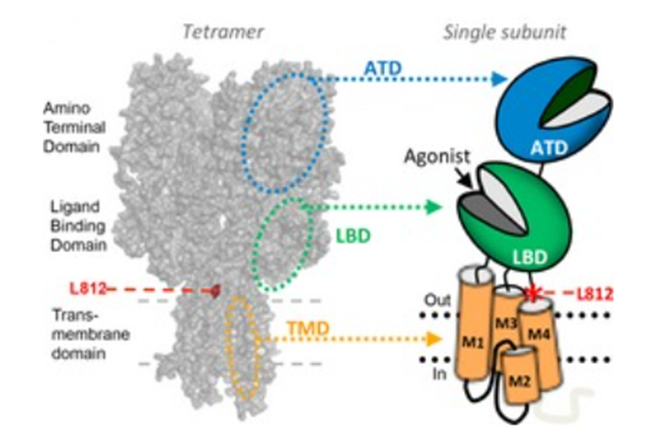- Home
-
Screening
- Ionic Screening Service
-
Ionic Screening Panel
- Sodium Channels
- Potassium Channels
- Chloride Channels
- Calcium Channels
- TRP Channels
- ATP gated P2X Channels
- ASICs
- Nicotinic Acetylcholine Receptors
- Ionotropic Glutamate-gated Receptors
- GABAa Receptors
- Glycine Receptors
- 5-HT Receptors3
- Cystic Fibrosis Transmembrane Conductance Regulators (CFTR)
- Other Ion Channels
- Stable Cell Lines
- Cardiology
- Neurology
- Ophthalmology
-
Platform
-
Experiment Systems
- Xenopus Oocyte Screening Model
- Acute Isolated Cardiomyocytes
- Acute Dissociated Neurons
- Primary Cultured Neurons
- Cultured Neuronal Cell Lines
- iPSC-derived Cardiomyocytes/Neurons
- Acute/Cultured Organotypic Brain Slices
- Oxygen Glucose Deprivation Model
- 3D Cell Culture
- iPSC-derived Neurons
- Isolation and culture of neural stem/progenitor cells
- Animal Models
- Techinques
- Resource
- Equipment
-
Experiment Systems
- Order
- Careers
- Home
- Symbol Search
- GRIN2A
GRIN2A
| Catalog | Product Name | Gene Name | Species | Morphology | Price |
|---|---|---|---|---|---|
| ACC-RI0174 | Human GRIN1/GRIN2A Stable Cell Line-HEK293 | GRIN2A | Human | Epithelial | INQUIRY |
The GRIN2A gene is a gene that encodes a protein called GluN2A (previously called NR2A). Studies have found that this protein exists in nerve cells (neurons) in the brain and spinal cord, mainly including areas of the brain related to language. The GluN2A protein is a component (subunit) of the NMDA receptor subgroup. There are several types of NMDA receptors, composed of different combinations of protein components. NMDA receptors are glutamate-gated ion channels, which can be found in excitatory synapses throughout the brain through Na+, K+ and Ca(2+). When brain chemicals called glutamate and glycine attach to the receptor, the channel opens and allows positively charged particles (cations) to flow through. The flow of cations generates an electric current that activates (stimulates) neurons and sends signals to the brain. NMDA receptors are involved in normal brain development, changes in the brain's response to experience (synaptic plasticity), learning and memory. They also seem to play a role in deep (slow wave) sleep. The GluN2A subunit of the NMDA receptor determines the location and function of the receptor in the brain. In addition, it also provides a location for glutamate binding.
GRIN2A Cloning and Expression
In 1993, scientists demonstrated through molecular cloning and cDNA expression that the epsilon and zeta subfamily of mouse glutamate receptor channel subunits constitute NMDA receptor channels. The four members of the mouse epsilon subfamily, E1 (GRIN2A), E2 (GRIN2B), E3 (GRIN2C) and E4 (GRIN2D), are different in distribution, functional properties and regulation. Later, the mouse E1, E2, E3, E4, and zeta-1 (Z1, or GRIN1) subunits were also isolated and named Nr2a, Nr2b, Nr2c, Nr2d, and Nmdar1, respectively. In the same year, partial cDNA and genomic DNA clones encoding human NMDA receptor channel subunits were also reported. Subsequently, the scientists used the rat NMDAR2 sequence to generate part of the NMDAR2A cDNA by PCR, screened the human cerebellum cDNA library, and cloned the full-length NMDAR2A cDNA. The predicted protein contains 1464 amino acids.

Figure 1. Protein changes of GluN2A. (Tyler Mark Pierson, et al.; 2014.)
GRIN2A and Diseases
Epilepsy-aphasia Spectrum
In some people with epileptic aphasia, more than 50 GRIN2A gene mutations have been found. The common condition of this disease is characterized by abnormal electrical activity in the brain during slow wave sleep, loss of speech and language skills, and sometimes other developmental problems. In addition, in many cases, the symptoms of the disease are recurrent epilepsy. Landau-Kleffner syndrome (LKS) and epileptic encephalopathy (ECSWS) with continuous spikes during sleep are at the severe end of the disease spectrum, while childhood epilepsy with central temporal sharp waves (CECTS) is at the mild end. Several other conditions have moderately severe signs and symptoms. Many GRIN2A gene mutations can cause the production of non-functional GluN2A protein or hinder the production of functional protein. These mutations may lead to a decrease in the number of NMDA receptors containing GluN2A subunits. Researchers speculate that the result of this change causes signals to pass through other types of NMDA receptors that are more likely to stimulate neurons, leading to excessive signals in the brain. Other mutations cause abnormal GluN2A protein production, may change the function of NMDA receptors, and may increase neuronal signal transduction. Excessive activity of neurons in the brain can lead to epilepsy and other abnormal brain activity, and may lead to neuronal death. Changes in GluN2A seem to particularly affect signals in areas of the brain involved in speech and language, and disrupt brain activity during slow-wave sleep, leading to some signs and symptoms of this group of diseases. It is unclear why some GRIN2A gene mutations cause relatively mild illness, while others cause more severe symptoms and signs.
Other Disorders
GRIN2A gene mutations have been found in people with neurological diseases. These patients have characteristics similar to epilepsy-aphasia spectrum disorder, but lack consistent language problems. These common features include recurrent seizures, usually due to abnormal activity in the Loran area of the brain (Roland epilepsy), intellectual disability, and developmental delay. Some people with mutations on chromosome 16 delete the GRIN2A gene and other nearby genes, and they also have unusual facial features.
References
- Burnashev N, et al.; NMDA receptor subunit mutations in neurodevelopmental disorders. Curr Opin Pharmacol. 2015, 20:73-82.
- Carvill GL, et al.; GRIN2A mutations cause epilepsy-aphasia spectrum disorders. Nat Genet. 2013, 45(9):1073-6.
- Turner SJ, et al.; GRIN2A: an aptly named gene for speech dysfunction. Neurology. 2015, 84(6):586-93.
- Wyllie DJ, et al.; Influence of GluN2 subunit identity on NMDA receptor function. Neuropharmacology. 2013, 74:4-17.
- Takano, H., et al.; Chromosomal localization of the epsilon-1, epsilon-3, and zeta-1 subunit genes of the human NMDA receptor channel. Biochem. Biophys. Res. Commun. 1993, 197: 922-926.
- Tyler Mark Pierson, et al.; GRIN2A mutation and early-onset epileptic encephalopathy: Personalized therapy with memantine. Annals of Clinical and Translational Neurology. 2014,1(3).
Inquiry
